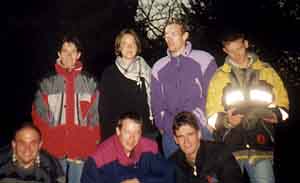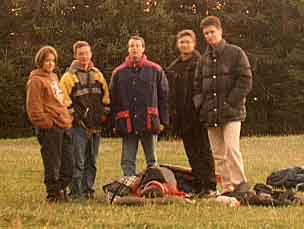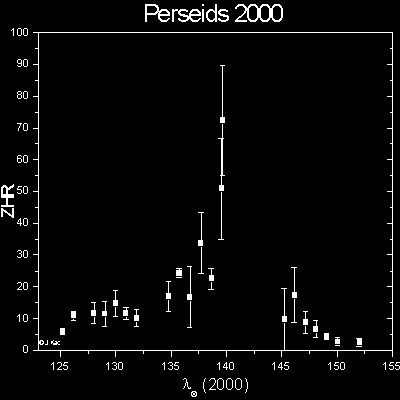Perseids 2000
After the missed 1999 Perseid peak, hopes were high for the coming peak of Perseids 2000. And clear weather there was, the entire night! Up to 115 Perseids per hour seen during the hour before dawn. A very good display, with a severe lack of fireballs. And that was not even the peak! We missed it by 8 hours, and it was 60% more intense than what we saw!
OBSERVATIONS
Early activity
note - during this interval the following observers were active: KACJA, ATAJU, ZAKJU, PETNA, KLAGR, DEVMI, ZAGDA, BIZPO, JERMA.
 The first Perseids were seen by MBK Team members as early as July 27, during the first observational night of the summer astronomical camp. The first activity can be seen as early as July 12, but could not be monitored this year due to the full Moon.
The first Perseids were seen by MBK Team members as early as July 27, during the first observational night of the summer astronomical camp. The first activity can be seen as early as July 12, but could not be monitored this year due to the full Moon.
But even on July 27, the rates were remarkably high, up to 6 PER/h under very good conditions. By July 31, the rates were up to 12 PER/h, with many bright, even negative magnitude class meteors. LMs during this intervals were between +6.7 anf +7.0! The trend of unusually high rates continued, with the top rates being seen between August 1 and 3, reaching no less than 22 PER/h. By the end of the camp, on August 4, the rates had declined somewhat, but still reached 12 PER/h. The LM was again between +6.6 and +6.9. A -3m Perseid fireball was seen by Jure Atanackov at 2:09 on August 3/4.
There was a short observational break on August 5 due to bad weather, but observers were out again on August 6/7 - Javor Kac and several members of the Team were observing from Mariborska Koca, while Jure Atanackov and David Zagorc were stationed at Graska Gora. Rates were up to 17 PER/h and the meteors were remarkably bright again. A -3m Perseid fireball was seen by Jure Atanackov from Graska Gora. The next night (August 7/8) Jure Atanackov and David Zagorc were observing from Graska Gora and saw rates up to 30 PER/h (LM +6.9).
On August 8/9 the team at Graska Gora rates up to 23 PER/h (although these were only in early morning as the radiant was still low). Later fog interrupted the observations, but a -3m fireball was seen during the watch. The team at Mariborska Koca had more luck. Their rates were up to 22 PER/h and they also saw three PER fireballs. The brightest was a -5m with 6 second train, the other two were -4m and -3m, also trained.
August 9/10 brought no better rates to the Graska Gora group - 26 PER/h, but again the observations were cut short well before the optimal morning hours for Perseids, so the top rate of the night would have been much better. Two -3m and a -4m PER fireballs were seen. Javor Kac had less than one hour of clear skies in Preloge and has witnessed rates of 15 PER/h.
The pre-peak night of August 10/11 brought dismal rates of only 20 PER/h to the group at Graska Gora. This time they were not only forced to end by 2am but also had constant obstruction from clouds. The group at Mariborska Koca had only half an hour of clear skies. Perseid rates were about 15 PER/h just post-midnight. The third group with Jure Zakrajsek observed from Hvar Island in good conditions but only saw just 21 PER/h.
Peak night

After cursing the Moon for the entire day, we were pretty fed up with doing that by the evening and we could concentrate on our work. 3 MBK Team members and 3 pending MBK Team members (KACJA, ATAJU, JERMA, DEVMI, STAMA, ZAGDA) converged at Mariborska Koca around 21:00 LT. By 22:00 the decision was made to move to Areh, as the conditions there would be better.
The rates were slow during the first hour, a combined effect of the strong moonlight and low radiant elevation, only about 15 PER/h were seen. By around 1:00 LT, the Moon had slid low enough for the LM to begin dropping visibly. It went from +5.7 to +6.1 during the hour. The rates also went up to over 30/h. By 2:00 LT, the sky was darkening by the minute and LM was approaching +6.5, with the rates climbing over 50 PER/h. The first fireball was seen (1:20:42 LT, a -3m yellow PER with 7 second train). The moon had set by 2:40 and the sky was then fully dark, with LM reaching +6.7! The rates exploded. At 2:26:12 the best Perseid of the night appeared, a bluegreen -6m Perseid fireball that left a 16 second train. Only 2 minutes earlier, a yellow -2m PER left a 17 second train. Between 3:15 and 4:15 rates were at their highest, between 70 and 115 PER/h. At 3:42:37 a -3m yelowgreen Perseid fireball occured, leaving a 7 second train.
In the last hour, the proportion of bright meteors increased and -1m became the dominant magnitude class! There were fairly few Perseids below +3m. All in all, it was a great night, with many many spectacular meteors, but a lack of fireballs.
After the peak
Full Moon on August 15 prevented further observations, although the night August 12/13 was clear and probably had rates around 1 of maximum rates. Observers resumed observations on August 18 and monitored dropping Perseid activity until August 26.
The rates at the beginning of the interval were still as high as 6 PER/h, but dropped below 1 PER/h by the end.
ANALYSIS
MBK Team analysis, combined with IMO analysis yields a good global picture of Perseid activity. First there is a very early peak of around ZHR 20 at around l¤ 130. This kind of early peaks has been noted in recent IMO studies and will need more research.
We can follow a steadily increasing ZHR towards the peak, but note that this year the ZHR was only running at about 2/3 of normal strength.
On August 11/12 at around 5 UT (l¤ 139.8) the secondary (cometary) peak was expected, but as it appears from early IMO studies, no pronounced peak occured at that time. There is, however, good evidence that the secondary peak was still present in 2000. On the ZHR chart, a distinct shoulder appears on the ascending part of the ZHR graph. First a steep rise in the ZHR is seen, then the ZHR stays stationary at just above 80 for 0.30 degrees l¤ and then rising again towards the annual maximum. Also, no reports have been recieved from the westernmost part of Europe where this peak would be most favourably observed (covering exactly the 5h UT interval).
The annual peak came at 140.0° l¤. In 2000 this peak was certainly notable for it's strength as it reached ZHR 130, quite unusually strong as the ZHR values for the annual peak are around 70 - 100. There are even some reports of increased fireball activity. Robert Lunsford described the peak 'To me it was better than average but definitely not a fireworks display.'
Not many reports were recieved for the night after the peak due to the unfavorable Moon phase, but the activity appears to have dropped to around ZHR 40.

A ZHR profile was made from MBK Team observations using a population index r = 2.6.

Details of the ZHR profile around maximum with combined with IMO data.
OBSERVATIONAL STATISTICS
| Observer |
Teff (h) |
Tot |
Spor |
PER |
CAP |
AQU |
SDA |
NIA |
NDA |
KCG |
PAU |
ACG |
| KACJA |
54.35 |
1212 |
492 |
486 |
48 |
114 |
17 |
12 |
5 |
28 |
10 |
|
| ATAJU |
52.49 |
1921 |
883 |
775 |
99 |
108 |
24 |
3 |
|
26 |
2 |
1 |
| JERMA |
40.53 |
908 |
341 |
376 |
71 |
58 |
25 |
|
|
37 |
|
|
| ZAGDA |
37.44 |
658 |
275 |
295 |
41 |
31 |
3 |
|
|
13 |
|
|
| ZAKJU |
25.70 |
570 |
317 |
138 |
27 |
66 |
16 |
|
|
5 |
|
1 |
| DEVMI |
20.99 |
453 |
195 |
195 |
25 |
30 |
|
|
|
8 |
|
|
| KLAGR |
13.00 |
254 |
119 |
116 |
7 |
6 |
|
|
|
6 |
|
|
| PETNA |
4.65 |
66 |
31 |
18 |
4 |
13 |
|
|
|
|
|
|
| BIZTI |
3.58 |
44 |
22 |
12 |
6 |
4 |
|
|
|
|
|
|
| STAMA |
3.06 |
39 |
18 |
21 |
|
|
|
|
|
|
|
|
| total |
255.79 |
6125 |
2693 |
2432 |
328 |
430 |
85 |
15 |
5 |
123 |
12 |
2 |
|


 The first Perseids were seen by MBK Team members as early as July 27, during the first observational night of the summer astronomical camp. The first activity can be seen as early as July 12, but could not be monitored this year due to the full Moon.
The first Perseids were seen by MBK Team members as early as July 27, during the first observational night of the summer astronomical camp. The first activity can be seen as early as July 12, but could not be monitored this year due to the full Moon.

